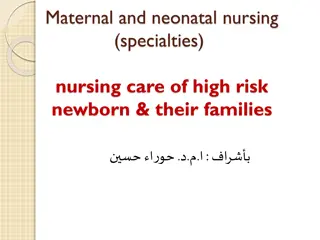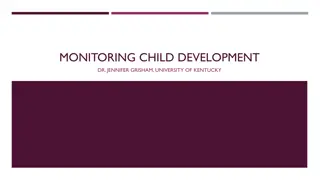Understanding Preterm Delivery: Causes, Complications, and Evaluation
Preterm delivery, defined as labor prior to 37 weeks of gestation, affects approximately 12% of pregnancies worldwide, with almost 30% of these deliveries occurring before 34 weeks. The etiology of preterm birth can vary from maternal factors such as PROM to fetal anomalies and multiple gestations.
0 views • 25 slides
Interesting Case Conference - Transfusion Medicine Rotation Laurie Lee, M.D., Ph.D.
One-day-old male infant admitted to the NICU for prematurity and respiratory distress, with a complex maternal history including multiple antibodies. Blood bank tests revealed a positive DAT, and molecular testing identified the patient as positive for JK*A and JK*B alleles. Interpretation suggests
0 views • 18 slides
High-Risk Newborn Nursing Care and Factors
Maternal and neonatal nursing specialties focus on providing care for high-risk newborns and their families, who face conditions endangering the neonate's survival. Factors contributing to high-risk newborns include high-risk pregnancies, maternal medical illnesses like diabetes, labor complications
0 views • 25 slides
Understanding Hydrocephalus: Causes, Characteristics, and Impacts
Hydrocephalus is a condition resulting from an imbalance in cerebrospinal fluid production and absorption, leading to swelling and pressure on the brain. It can occur due to various reasons like congenital factors, prematurity, spina bifida, meningitis, or brain tumors. The condition manifests diffe
0 views • 35 slides
Understanding Child Development and Assessment in Neonatal Abstinence Syndrome
This presentation discusses the importance of progress monitoring, strategies for assessing children with Neonatal Abstinence Syndrome (NAS), and developmental outcomes assessment needs. It covers topics such as prematurity assessment, physical well-being evaluation, cognitive development, and motor
0 views • 18 slides
Overview of Pulmonary Hemorrhage in Infants
Pulmonary hemorrhage in infants is a severe condition characterized by bloody discharge from the upper respiratory tract or endotracheal tube, often associated with prematurity, lung complications, infections, or trauma. The etiology, pathophysiology, clinical manifestations, and diagnosis of pulmon
0 views • 14 slides





